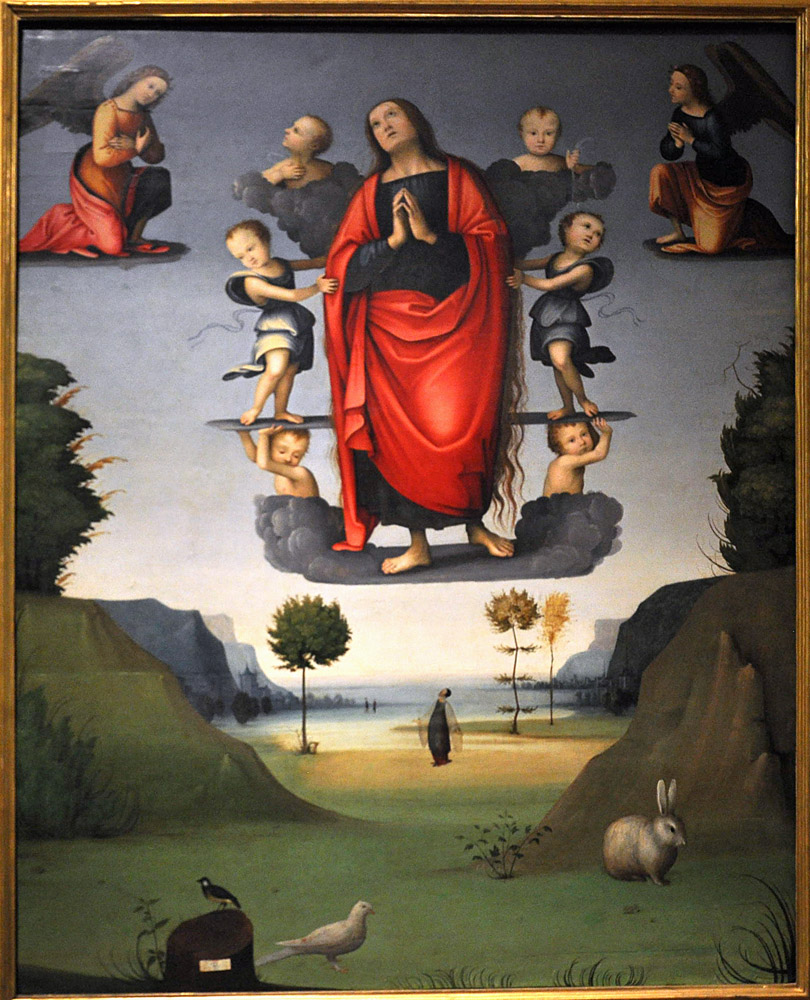
Master of the Assumption of the Magdalene
The Assumption of Mary Magdalene
Circa 1506-1507
Oil on panel
Pinacoteca Nazionale, Ferrara, Italy
Provenance: Church of St. Andrew, Ferrara
The above title is supplied by the gallery's label, but the occasion pictured is probably not the ascent of the Magdalene's soul into Heaven, which according to the Golden Legend was witnessed by the bishop and clergy of Aix-en-Provence. Instead, just one man gazes up as the saint rises into the heavens. The man is most likely the hermit in the Golden Legend who was allowed to see one of the saint's ecstasies: "he saw with his bodily eyes in what manner the angels descended into the place where the blessed Magdalene dwelt, and how they lifted her in the air, and after by the space of an hour brought her again with divine praisings to the same place."
The awestruck hermit serves to model the response expected of a viewer. St. Andrew's was the church of Ferrara's Eremitani Augustinians, and the painting as a whole presents Mary Magdalene as the ideal of the
eremetical
adjective: relating to hermits
life. The Legend reports that angels lifted her up to Heaven "at every hour canonical" – that is, at each of the hours of the day when monks gather to pray. There she could hear "the glorious song of the heavenly companies." Ideally any contemplative's prayer will be, like hers, a lifting up of oneself to the heavenly chorus.
Each of the three creatures in the foreground has something to teach about Mary Magdalene's life as a hermit. On the basis of the yellow breast and conical beak I take the bird on the tree stump to be a female goldfinch, though usually the patch on that bird's head is red, not white. According to Isidore of Seville the goldfinch feeds on thorns and thistles, so later commentators related it to the passion of Christ.1 In the present context, the bird points to the severity of Mary Magdalene's eremetical life as a participation in that passion. In the Legend, "she had no comfort of running water, ne solace of trees, ne of herbs. And that was because our Redeemer did do show it openly, that he had ordained for her refection celestial, and no bodily meats."
The turtle-dove in the center foreground was thought to stay monogamous even after the death of its mate. The Physiologus makes this into a counsel for the life of the "spiritual" person: "when loaded with sin you see it is time for penitence, cast away crooked works and do not entangle yourself in new filth, that is, sins; but be content with your one spouse, that is, contain yourself within proper limits, so that you will find your home at the second coming."2 This is particularly relevant to Mary Magdalene, who lost Jesus her "spouse" once but waited to meet him again "at the second coming."
The hare is usually a symbol of lust, but two passages in scripture commend it as a creature that "hides in the cleft of the rock." Augustine and others interpret the rock as Christ, who enables the one who flees sin "to stand firm in this world against all temptations."3 Mary Magdalene is just such a person, a former sinner living the contemplative life in the rocky cave so often pictured in her portraits.
Finally, the eremetical ideal is expressed in the serenity of the image – the soft palette, the man's gauzy mantle, the tolerance of open spaces, the stately progress of the cliffs receding into the background, the unhurried attitudes of the children (not angels, not even putti) lifting the saint.
View this image in full resolution.
Read more about images of St. Mary Magdalene.
Read the Golden Legend's Life of St. Mary Magdalene.
Photographed at the site by Richard Stracke, shared under Attribution-NonCommercial-ShareAlike license.